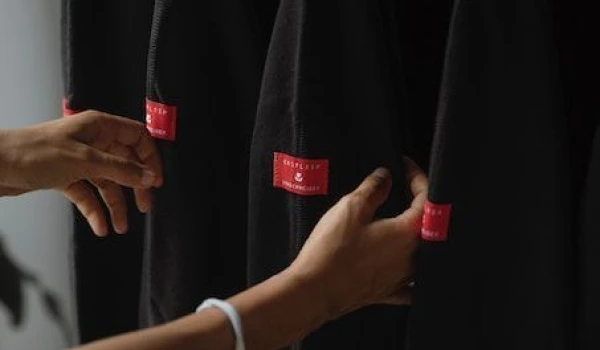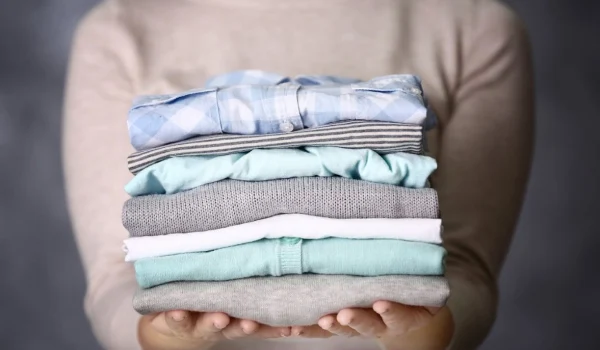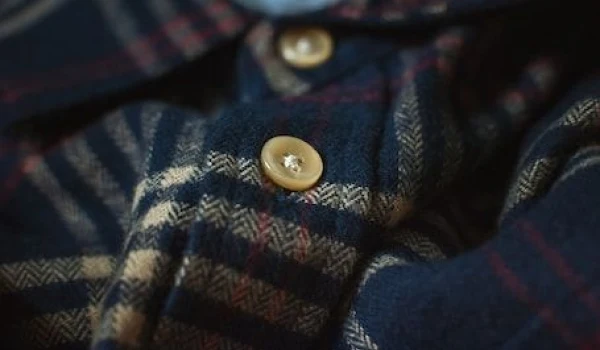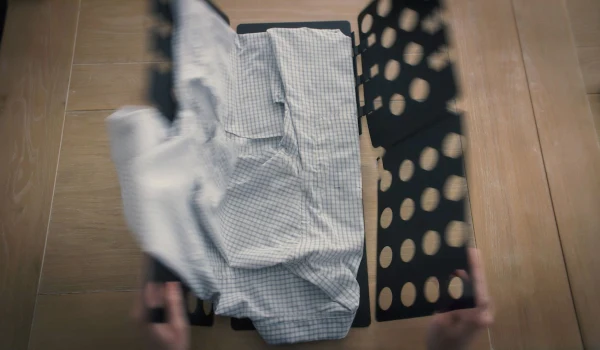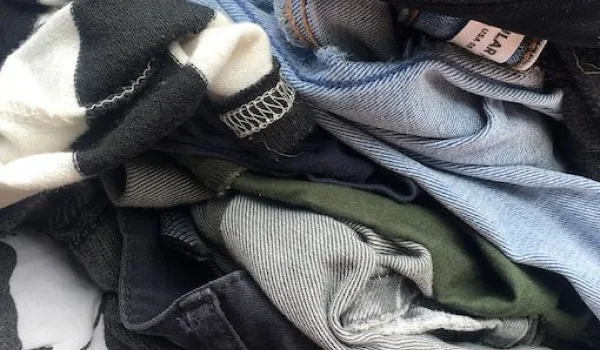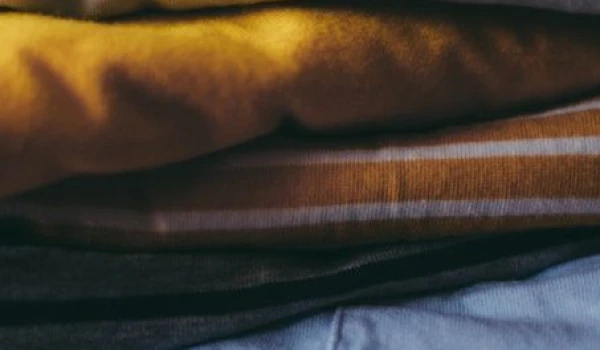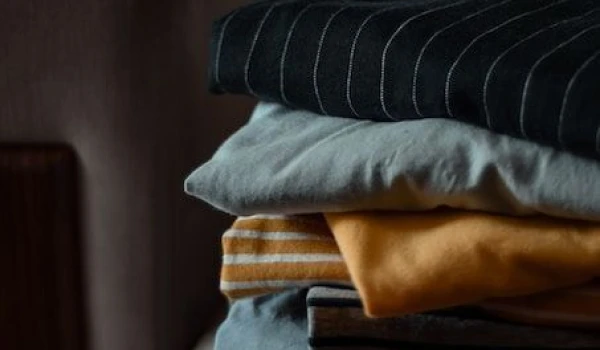Care
Clothing care tips to make your wardrobe last

It’s a question that you’ve likely asked yourself on numerous occasions, but haven’t gone out of your way to answer… until now. We're here to set the record straight and make the dry cleaning process a little less mysterious.
In the simplest of terms, dry cleaning is a process of cleaning clothes without the use of water. The absence of water in the process is where the name dry cleaning comes from (one mystery solved). Instead, dry cleaning uses non-water based chemical solvents to clean clothes.
In more complex terms, the dry cleaning process has quite a few steps to it: Inspection and Tagging, Pre-Spotting, The Dry Cleaning Process, Post Spotting, Finishing Touches.
Here are what these steps entail:
- Inspection and Tagging Process: This is one of the parts that you’re likely most familiar with. You take your garment into the cleaner's, and the dry cleaner creates a tag for your item. This is also when your clothes are examined for any stains, missing buttons, tears, etc.
- Pre-spotting: Here is where things begin to get a little hazier for the average dry cleaning customer. Once we’ve dropped off our garments, cleaners will typically go through a pre-spotting process where they’ll apply a chemical solvent, vacuum, or heat to stains on your garment, which helps to remove the stain during the actual dry cleaning process.
- The Dry Cleaning Process: This is the part we never see. Once your clothes have been pre-spotted, your clothes are placed into a machine and submerged into a non-water based solvent. The clothes are then rotated in a perforated cylinder where the cleaning solvent is released in a steady amount throughout the entire process. From there, the machine rapidly spins the clothes to get rid of any excess solvent and releases warm air. Your clothes emerge completely dry.
- Post-spotting: Here your cleaner will inspect your clothes for any remaining stains and residue and remove them using the same process they did in the pre-spotting stage.
- Finishing: Once your clothes have gone through the complete dry cleaning process, they are pressed, steamed, or ironed for presentation. This is the part we love because it makes our clothes look and feel amazing.

Dry Cleaning can be beneficial for garments made from fibers that don’t react well when exposed to water, like silk and wool. It’s also good for garments that shouldn’t be exposed to the heat of a traditional dryer.
While the dry cleaning process is inherently opaque to the average customer since everything happens "behind the scenes," all in all, it’s pretty straight forward once you understand the steps. If you’re interested in having an item dry cleaned, schedule a Rinse, and try our Dry Cleaning/Launder & Press service.

Jeans come in different shapes, sizes, and types of denim. We'll help you understand how to properly care for your jeans so that you can wear them more often.
Once you’ve found the perfect pair of jeans, there’s no way you’re giving them up. Whether they’re trusty blue bootcuts or white skinnies, your jeans need proper care so they’ll look great no matter how often you wear them. You might feel a bit nervous caring for your jeans, though. After all, you’ve heard that washing denim too often can cause the color to fade. How can you ensure that your go-to pair stays clean?
Look no further than this handy denim guide. We break down everything that goes into caring for denim so you can make sure your jeans last as long as they’re in style—and a good pair never goes out of style.
Raw vs. pre-washed
Knowing the difference between raw and pre-washed will help you take better care of your denim.
Pre-washed denim: Just as the name suggests, this type of denim has been washed before you bought it. This is to help the denim maintain its original shape. With pre-washed jeans, you’ll run into fewer problems when cleaning, but it’s still a good idea to use the washing machine sparingly.
Raw denim: Darker in color than pre-washed denim, raw jeans can take months (and even years) to break in. After repeated wears, they’ll develop natural creases and snugly fit the contours of your body. This type of denim hasn’t been washed before, and may shrink slightly in water.
Pre-washed denim
Avoid washing too often

Contrary to popular belief, jeans don’t need to be washed after every wear. In fact, as long as your jeans aren’t stained, you can wear them multiple times before they need to be cleaned. Generally, you should wash your denim after five wears.
Be sure to turn your jeans inside out before you throw them in the washing machine.
For blue denim: Use cold water on the gentle cycle.
For white denim: Use warm water on the same cycle and avoid bleach, which can cause your denim to turn yellow over time.
Always air dry: After washing your jeans, make sure to air dry them. This will prevent the denim from shrinking and fading in color. While you’ll want to dry your blue denim away from sunlight, the reverse is preferred for your white jeans. Sunlight serves as a natural bleaching treatment so air dry your white denim out in the open.
Raw denim
Freeze the bacteria away

Raw denim hasn’t been exposed to water before, so soaking it can cause the material to shrink. As a cleaning workaround, you can kill any bacteria by placing your raw denim in the freezer. Follow these instructions for a crisp, clean feel to your jeans:
- Fold your jeans and place them in a large ziplock bag.
- Seal the bag and store it in the freezer overnight.
- After you’ve removed them from the freezer, let your jeans warm up a bit before you wear them—unless you like feeling chilled.
Keep in mind that the freezer treatment isn’t intended for cleaning stains. If you find that you’ve spilled something on your favorite pair, rub a small amount of water and liquid detergent onto the stain. Leave it for a few minutes, then wash it out and let your jeans air dry.
Spot clean stains
Here’s how you can remove common stains from your jeans.
- Mud and grass: Wait until the stain dries, then wipe away any excess dirt. Mix some water and soap, and use a toothbrush to scrub the cleaning solution into the stain.
- Grease and oil: Blot with a paper towel to soak up any excess oil. Wipe the stain with a cloth dipped in soapy water.
- Red wine: Pour a bit of white wine over the stained area and then blot with a clean cloth.
Afterward, be sure to rinse with cold water. These stains are likely to happen while you’re on the go—have a stain remover on hand so you can pre-treat right away.
Keep these DIY denim care tips in mind next time you’re cleaning your favorite pair. Taking proper care of your jeans means you can wear them as long as you’d like.
Photos: Unsplash, PDPics, Chay Talanon / Shutterstock.com

Think of your favorite coat or jacket. Now, try to think about the last time you had it cleaned. It’s easy to forget to care for outerwear as the seasons change and your wardrobe staples rotate, but just like your trusty pair of blue jeans, your coats and jackets needs regular care to keep looking good.
We’ve outlined basic guidelines to help you decide when to clean your outerwear, so you can give these pieces top-notch treatment.
Consider the fabric

The fabric of your coat or jacket is one of the key factors in deciding how frequently it needs to be cleaned.
- Down jackets, leather jackets, and wool coats: Once a season, if worn sporadically; twice a season, if worn regularly.
- Suit jackets and blazers: After four to five wears.
- Fleece jackets: After six or seven wears.
- Rain jackets: Once a month, if worn infrequently; twice a month, if worn regularly. You should also use a durable water repellent finish to ensure the jacket’s waterproof coating is doing its job.
By the end of the season
In order to prolong the life of your coat or jacket, don’t forget to tend to your outerwear during the offseason. Before storing it at the end of the season, make sure your jacket is clean—even if you don’t see any visible traces of dirt or stains. Moths are attracted to perfume and food odors, so if your coat or jacket isn’t freshly cleaned, it can end up with pesky moth holes.
While many coats and jackets can be hand washed or machine washed, dry cleaning is ideal for wool coats or ones with embellishments.
Keep in mind that leather jackets require special care; leather can’t be exposed to water, so bringing it to a specialty cleaner will ensure your jacket gets professional treatment.
Pro-tip: Let the clothing care experts at Rinse take care of your coats and jackets and we’ll make sure they are returned cleaned and ready-to-wear. We offer Wash & Fold, Dry Cleaning, and Leather Cleaning - no matter what type of coat you have we’re able to take care of it. Schedule a pickup on our homepage.
Storage considerations

Clean outerwear and appropriate storage go hand in hand. In order to ensure your outerwear is in excellent condition for the following season, you want to make sure everything is taken out of your coat or jacket pockets. Besides that, check that the zippers are zipped, buttons are buttoned and snaps are snapped. This will help your coat or jacket maintain its original shape.
When it comes to storage, your outerwear, especially a leather jacket or down jacket, needs to be given room to breathe. This means you shouldn’t store your coats or jackets in plastic garment bags but rather in fabric storage bags. Plastic bins are also acceptable, but only if you don’t store too many coats and jackets in one bin.
By following these cleaning and storage guidelines, you can continue to wear your coats or jackets in the years to come. After all, they keep you warm and cozy through cooler weather, so they deserve a little TLC in return.
Photos: progressman / Shutterstock.com, Dmitry_Tsvetkov / Shutterstock.com, topnatthapon / Shutterstock.com
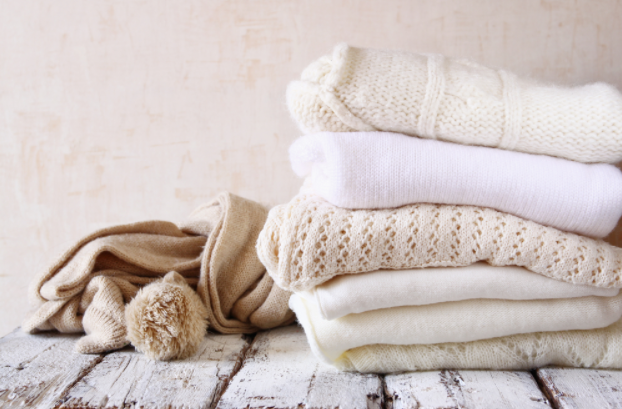
Learn what's best for cashmere items and how to care for them.
Soft, luxurious, and high maintenance—these are the first few of the things that come to mind when people think of cashmere. While this delicate fabric does require a bit of attention, don’t let that stop you from upgrading your wardrobe with a few cozy cashmere pieces. If you clean, dry, and store your cashmere properly, it’s easy to keep it in excellent shape.
Take a deep breath and let us guide you through the process—it’ll be pain-free, we promise.
Washing and drying: by hand, machine or professional
Yes, it’s possible to clean your cashmere at home. Whether you’re washing a sweater, dress or scarf by hand, these steps will help you keep your cashmere fresh.
- Fill your basin with cold water, and add a mild detergent such as Woolite, baby shampoo, or dish soap.
- Let your cashmere soak in the basin for five minutes, before rinsing thoroughly.
- Take out your clothing and fold it up into a ball to get the excess water out. Don’t wring your cashmere, which can stretch out the delicate material.
- Place your clothing flat on a towel, and roll it up to remove any remaining water.
- Lay your clothing on a drying rack. If you don’t own a drying rack, place it between two towels to dry.
Don’t have the time to wash by hand? This might surprise you, but you can use a washing machine to clean cashmere. Put the garment in a laundry or mesh bag before you place it in the machine, and select the gentle cycle on cold water. If you’d rather have a professional do the job, dry cleaning is always a good option for your cashmere.
At Rinse, our Dry Cleaning and Wash & Fold services are conveniently available 7 days a week. Visit our homepage to create your free account and schedule your first pickup. We have decades of experience cleaning cashmere!
Care tip: Ideally, you should clean cashmere after wearing it two to three times. In between washings you can remove any fabric pills with a cashmere comb or bristled garment brush. Pills don’t mean the cashmere you purchased is cheap—they’re simply a sign of friction from wear.
Stain removal: food, drinks and cosmetics

No matter how careful you try to be, you might end up with a small stain on your sweater. Your initial urge might be to panic, but you can keep your cool—and your cashmere—by following our handy stain removal advice.
- Makeup or grease-based: First blot the stain. Then, pre-treat by soaking the cashmere in mild shampoo.
- Chocolate: Dip a cloth in liquid detergent and lightly rub the stained area, taking care not to scrub too hard.
- Red wine, tea, or coffee: Gently rub the stain with a cloth dipped in a mix of cold water and dish-washing liquid. Avoid soap or machine detergents, which can set red wine stains rather than remove them.
Afterward, rinse your garment in cold water and let it dry on a rack. Your cashmere should be as good as new!
Storage: long-lasting care
To keep your cashmere looking its best, keep these tips in mind.
- Don’t hang your cashmere sweaters or dresses. A hanger will distort the shoulders, and the garment will lose its original shape.
- Instead, fold your cashmere and keep it in a drawer or on a shelf away from moisture.
- When you’re putting your cashmere away for the season, place it in a breathable garment bag or storage box in a cool, dry area. To prevent wrinkles, you can wrap each piece of cashmere clothing in acid-free tissue paper.
- Remember to make sure your cashmere is washed before you store it for the offseason. Moths are attracted to human scents, so you’ll want to get rid of any perfume or food odors prior to storage. As an added precaution, place some cedar wood moth repellents with your cashmere.
Now that you’re fully equipped to care for cashmere, go ahead and stock up on this comfy and luxurious fabric in time for sweater season. You’ll look good and feel good!
Photos: Tamarcus Brown, Ann Haritonenko / Shutterstock.com, tomertu / Shutterstock.com

Learn how to extend the life of your warobe by cleaning your pieces the right way at the right time.
You finally have a well-organized closet with all the key pieces for casual, work, and formal occasions. Now all you need to do is make sure your favorite attire looks fresh. Dry cleaning your clothes is a great way to help keep them in great shape, but not every item in your wardrobe needs to be cleaned after each wear.
How do you decide when a trip to the dry cleaner is necessary? Our guide explains when certain types of clothing need cleaning, so you can easily extend the lifespan of your wardrobe essentials.
Business and formal suits

Suits don’t come into direct contact with your skin, so you don’t always need to dry clean them each time you wear them. That said, there are some distinctions to be made between business and formal suits. For instance, you’ll wear your business suit on a regular basis while you’ll only suit up in your formal wear for special occasions like weddings or black tie events.
When should you Dry Clean them?
- Business suits: After four to five wears
- Formal suits: After each wear (or once a season)
Care tip: Spot clean and brush your suits at home in between the dry cleaning cycle. You’ll be able to get more wear out of these items without needing to wash them as often.
Pants, skirts and dresses
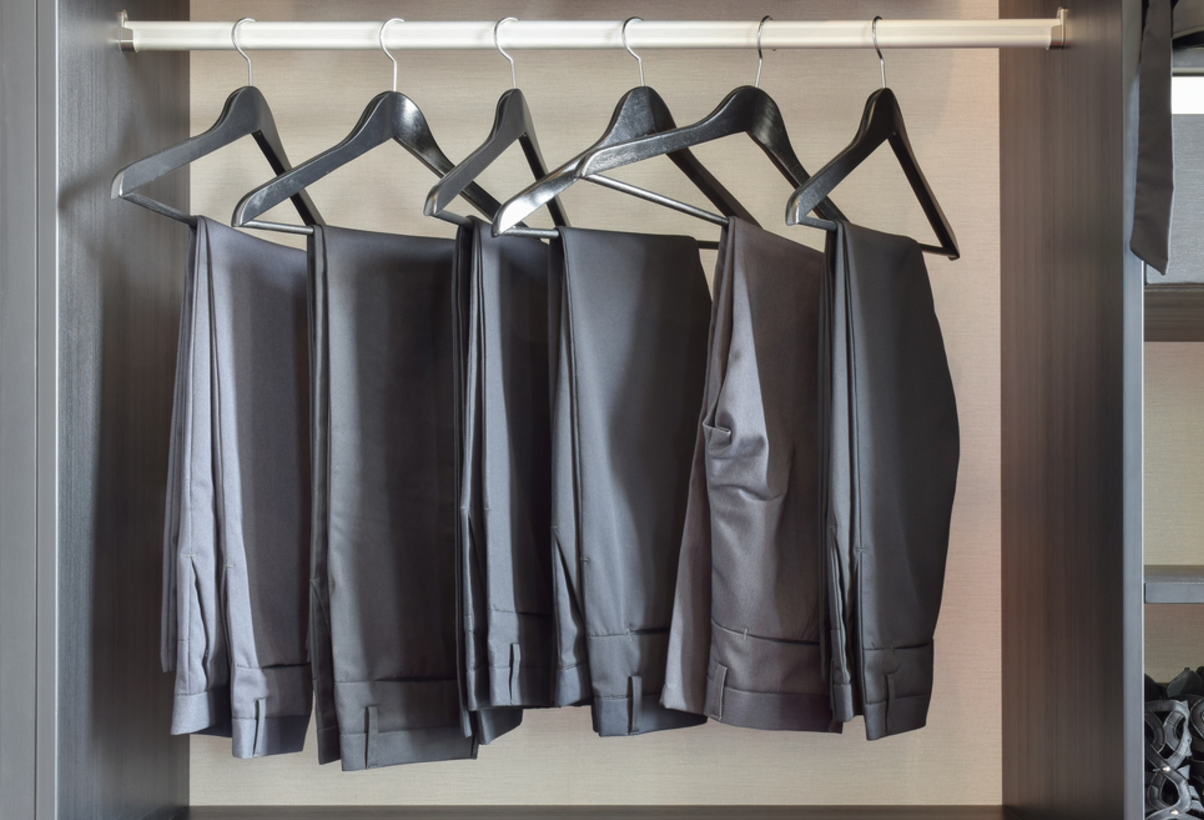
If your dress pants or skirts are made of a stain-repellant material, you can wear them a few times before you need to bring them to the dry cleaner. However, formal dresses will need to be cleaned more often due to their fragile material.
When should you Dry Clean them?
- Dress pants and skirts: After four to five wears
- Formal dresses: After each wear
Care tip: Air out your pants, skirts and dresses by hanging them after you’ve worn them.
Button-down shirts and blouses
Button-down shirts and silk blouses fit close against your skin and absorb your sweat so they’ll require regular trips to the dry cleaner. It’s also a good idea to visit the dry cleaner when you need your shirt pressed because a professional can ensure it gets top treatment.
When should you Dry Clean them?
- Button-down shirts: After three to four wears (or each wear, if the shirt is white)
- Silk blouses: After each wear
Care tip: Ask your dry cleaners not to use starch for your button-down and dress shirts. You can also wear an undershirt to absorb sweat. Both of these tricks will help extend your shirt’s life expectancy.
Other considerations to keep in mind
Of course, these rules aren’t set in stone. In fact, there are other variables that can affect how often you need to visit a dry cleaner.
- Fabrics: Clothing made of wool can be worn more often before they need to be cleaned. Delicate fabrics like cashmere and silk are vulnerable to sweat, so they’ll need more frequent care.
- Frequency of wear: If you wear your suit to work almost every day, it can end up slightly wrinkled or stained over time. Same goes for any attire you wear on a regular basis.
- Weather and temperature conditions: Working in a warm locale like downtown LA? Your clothes will absorb more sweat and—unpleasant as it is to think about—more odors.
- Stains: While you can pre-treat a stain, there are some stubborn residues that call for a professional touch.
- Important events: You’ll need to look your best if you’re attending an upcoming wedding or client meeting. Professional treatment will ensure that you enter a room in an outfit that will make the right impression.
The key to a happy closet is to ensure your important pieces stay spotless and clean for as long as possible. That way, you can get the most out of your wardrobe essentials.
Not sure which clothes should be dry cleaned? Check out our guide to learn which items need professional care and which ones you can take care of at home.
If you have items that need to be dry cleaned, schedule a pickup with us here. We pick up, professionally clean, and deliver your dry cleaning and laundry straight to your door, 7 days a week.
Photos: All About Space / Shutterstock.com, Sveta Yaroshuk / Shutterstock.com, WorldWide / Shutterstock.com, nnattalli / Shutterstock.com

Workout attire is oftentimes made of delicate materials. Read our guide on how to properly care for your workout clothes.
You work hard to stay in shape so it's important that your workout clothes do the same. A lot of activewear today is made of technical fabrics that wick moisture away from the body so you can stay cool up to the last rep. These diligent yet delicate materials require special care to get them clean and ensure they last for many more workouts.
Air Out Your Gym Clothes
Here's how to care for your gymwear so that it's ready for your next workout session.

After your workout, air dry your gym clothes by hanging them outside. Never let your sweaty tank top stay crumpled in the depths of your gym bag. Not only is this one smelly mistake, but keeping a sweaty garment trapped in a bag or laundry basket for a long period of time can breed mold and mildew.
Care and clean
Most synthetic workout fabrics like polyester, Lycra, and spandex are machine washable in cold water, but extra care must be taken to preserve the shape, elasticity and technical capabilities of each garment.
Separate and wash like with like items
You've likely mastered the art of separating lights and darks, so let's take it one step further by separating your workout gear so that you're washing like fabrics together. Mixing and washing synthetics and pieces of cotton together can cause abrasion, resulting in greater wear and tear on your workout clothes. Also, refrain from throwing in your dirty gym towel with your gym gear as the cotton fluff from the towel can cling to nylon and spandex. The same goes for anything with zippers or velcro, which can cause friction against delicate workout fabrics.
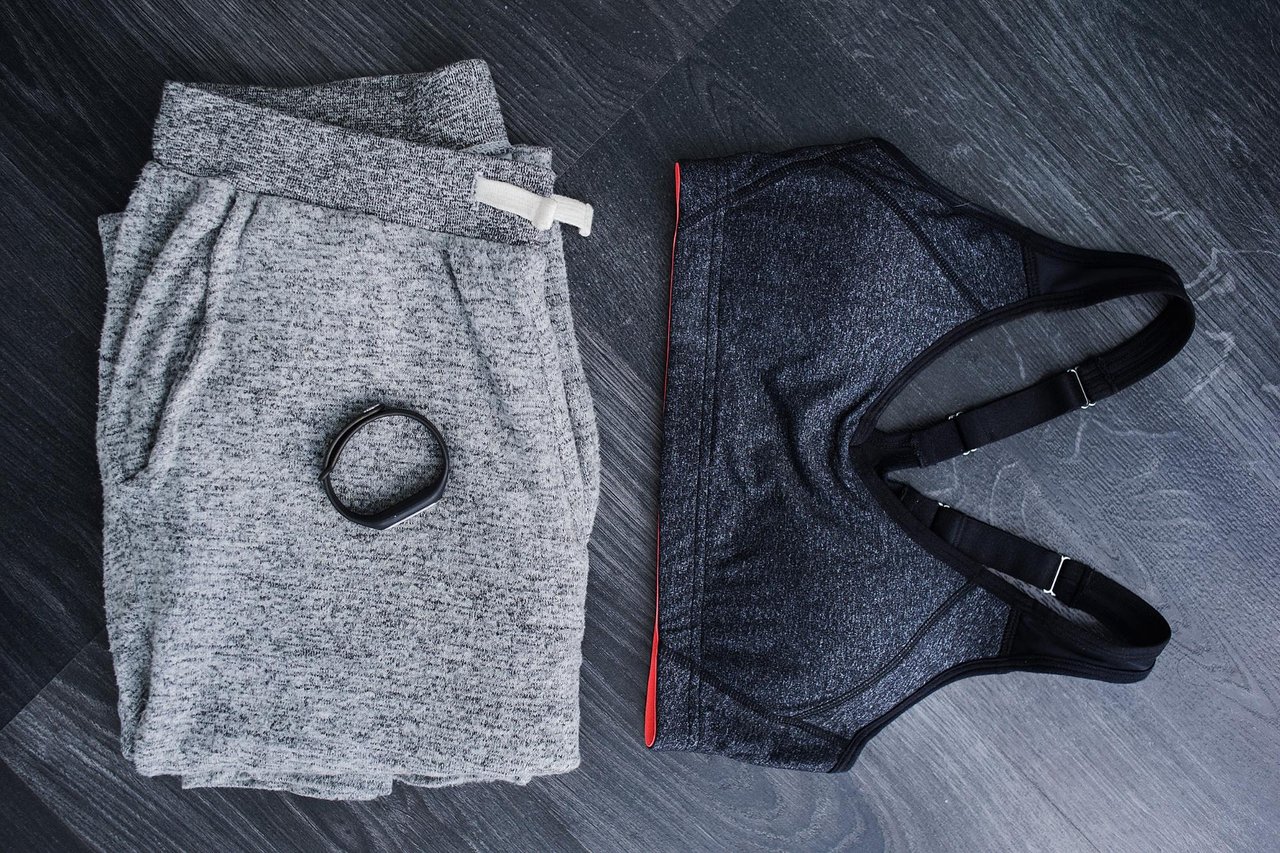
Wash in cold water
Hot water can cause shrinkage and decrease the performance of technical fabrics so it's ideal to wash your gear in cold water.
Use less laundry detergent
It may be tempting to put in more detergent to get the sweat smell out, but it's better to use three-quarters of what you'd use for a normal load as the extra detergent can cling to your workout clothes.
Keep the fabric softener away
While we love the fresh scent of fabric softener, workout clothes and fabric softener are an unfortunate pair. Fabric softener breaks down the elasticity in stretchy fabrics like nylon and spandex. It also creates a barrier on the garment, which traps in odors and clogs the pores of technical fabrics, decreasing their moisture-wicking capabilities.
Dry and repeat
While your workout gear works as hard as you do, it does require delicate care and attention to keep clean and prolong its life. These tips will help you make sure your gym clothes stay tough enough to handle whatever fitness regimen you put them through.
After washing, it’s important to hang your workout gear and let it air dry because heat from the dryer can damage technical fabrics and cause your clothes to change in shape. You can schedule a Hang Dry service with rinse, 7 days a week.
Photos: ARTFULLY PHOTOGRAPHER / Shutterstock.com, PublicDomainArchive, Daria Grebenchuk / Shutterstock.com
Topics
Rinse Drop
We offer pickup and delivery if you can’t be present between 8pm and 10pm.
Our Valet will pick up or deliver your order to your doorstep or concierge, at which point you’ll receive a text with a photo showing where your items were left.
You can enable Rinse Drop on any (or all) of your orders.
Rush Delivery
We offer Next-Day Rush Delivery for Wash & Fold orders for an additional fee of $9.95.
Simply let your Valet know upon your pickup. There’s also an option to set a permanent preference for Rush Delivery in your My Account page.



